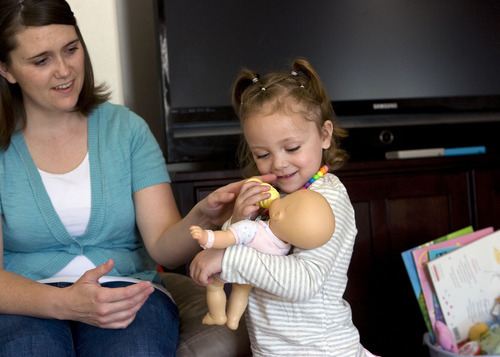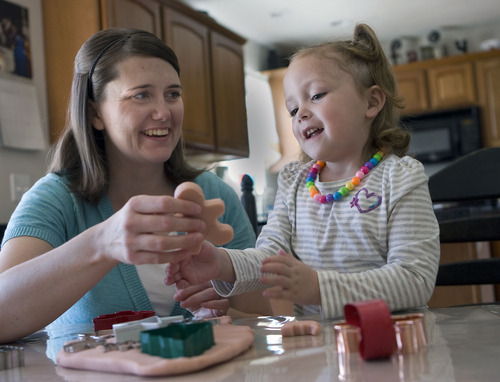This is an archived article that was published on sltrib.com in 2011, and information in the article may be outdated. It is provided only for personal research purposes and may not be reprinted.
Her belly swollen with fluid and her liver infected, Eden Lai was in the hospital six times in six months.
The 1-year-old was a candidate for a liver transplant, but her parents knew it could take several months or longer to get one from a deceased donor. Though her liver was failing, she wasn't one of the sickest patients.
So in 2009 her mother decided to give a portion of her own liver to save her daughter.
"She had a big belly and really skinny arms and legs. She wasn't getting nutrition," said 32-year-old Erica Lai, of Spanish Fork. "I didn't want to watch her get sicker than she already was."
That option — a living-donor liver transplant — hasn't been an option for adults in Utah since 2008.
Now the same surgical team that transplants segments of livers from living donors at Primary Children's Medical Center is ready to do the same at Intermountain Medical Center for adults dying from liver disease.
With 146 Utah adults in need of a liver transplant — some for more than five years — waiting for a donor to die isn't always possible. Statistically, about 30 of them will pass away before they get a transplant.
"If you are waiting for the cadaveric [transplant], it's a gamble," said Shiro Fujita, a liver transplant surgeon at both hospitals, noting that 2,000 U.S. adults die each year waiting for a liver transplant.
Fujita was recruited to Utah in 2009 to restart the Liver Transplant Program at Intermountain Medical Center, which ended in 2008 after just five surgeries when one of the liver surgeons retired.
As part of the first generation of transplant surgeons in Japan, Fujita, 55, started performing living liver transplants in 1998 in his home country, where transplants from brain dead donors weren't legal until 1997. He also created the University of Florida's living liver transplantation program.
Fujita has performed 63 living liver transplants including a handful at Primary Children's — a track record that may alleviate the high complication rates found at transplant centers with less experience with living-donor transplants, such as Intermountain.
"He is probably one of the most experienced live-donor liver surgeons in the country because of his extensive experience in Japan," said Willem Van der Werf, chief of Intermountain's Division of Transplant Surgery.
This summer, the United Network for Organ Sharing approved Intermountain's adult program. UNOS manages the national waiting list and matches donors under contract with the federal government.
Van der Werf said the option is critical for a state such as Utah, where statistics show patients have to wait longer and are sicker by the time they receive a transplant from a deceased donor. Utahns needing a liver have one of the nation's longest waits: an average of 1½ years.
The wait could become longer under proposed changes to the national allocation system. Van der Werf said instead of livers from deceased donors being used within the state, they could be sent to the sickest patients in the region, which includes much larger states — with more sick patients — such as California.
"The pressure will be on for everybody to have to get really sick before they can be transplanted. That makes live-donor liver transplant a more attractive option, since patients already have about a 10-to-15-percent chance of dying before they can reach transplant," he said.
Fujita became a transplant surgeon while caring for children in Japan who suffered the same congenital disease Eden Lai had — biliary atresia. It's a blockage in the ducts that carry bile from the liver to the gallbladder.
Eden's jaundiced skin and pale stool revealed the disease. Since the 2009 transplant, the now 3-year-old is healthy, Erica Lai said.
"I was in the hospital one week. It was definitely the most painful surgery I've ever had," said Lai, who had a Cesarean section and has had gallbladder surgery. Still, she got pregnant within a year after the surgery. "It took a couple months to really get back to normal."
A parent giving a portion of his or her liver to their child can be an easy call. But among adults, the surgery is more ethically complex. A healthy person, usually younger than the recipient and possibly with a family of their own, is put at risk, Fujita said.
Surgeons have to remove around 60 percent of an adult donor's liver. The remaining portion and the transplanted lobe will grow, but research has shown donors commonly suffer complications. A study of adult-to-adult transplants showed about 38 percent experience problems, most often bacterial infections and bile duct leaks. A small percentage developed psychiatric problems, including suicide.
The risk of death for a liver donor — 1.5 in 1,000 surgeries — is five times higher than from more common living kidney donations, according to a 2008 review of live donors in liver transplantation in the journal Gastroenterology. Five of more than 3,500 donors were listed for transplants themselves between 1994 and 2008, according to government data.
But risks must be weighed against the benefits: A 2011 study in the journal Hepatology of nearly 900 livingliver-transplant candidates showed a "significant survival benefit" for most recipients of living donations compared to receiving a liver from a deceased donor or waiting for one.
Fujita said many adult patients would rather wait for a liver from a deceased donor because they don't want to put a family member at risk. But as they languish on the waiting list, they become more willing to seek help.
"For most patients their lives are essentially on hold just waiting," Van der Werf added. "They're not able to work, they're not able to do the normal things they would like to do."
He expects the hospital to perform a couple of transplants a year from living donors. The number is small because the sickest patients are likely to get a liver from a deceased donor quickly, and those who are healthier have a higher risk of dying from the transplant than from waiting.
Plus, the recipient needs to be small — the donated portion of the liver should be about 1 percent of the recipient's weight — and the donor must be a healthy match.
Still, Fujita said Utah's strong good Samaritan kidney program may translate to good Samaritan liver donations.
Lai was glad hear about the new adult program. She's not worried about her own liver — which is functioning normally — but Eden's.
"She may need another transplant at some time."
Living liver transplants in Utah
Since 1997, 30 transplants have been done, all but five in children. Of the donors:
21 • From parent
2 • From child
3 • From other blood relative
1 • From a spouse
3 • Unrelated donor
Age breakdown of 30 living-donor recipients
10 • Under 1 year
11 • 1-5 years
2 • 6-10 years
2 • 11-17 years
1 • 35-49 years
4 • 50-64 years
Source: Organ Procurement and Transplantation Network —
Status of liver transplants, U.S.
As of mid-October:
16,215 people were waiting for a liver transplant.
3,640 have received a liver transplant since January.
Since 1989, 4,427 living liver transplants have occurred, representing 4 percent of total liver transplants.
Source: Organ Procurement and Transplantation Network







